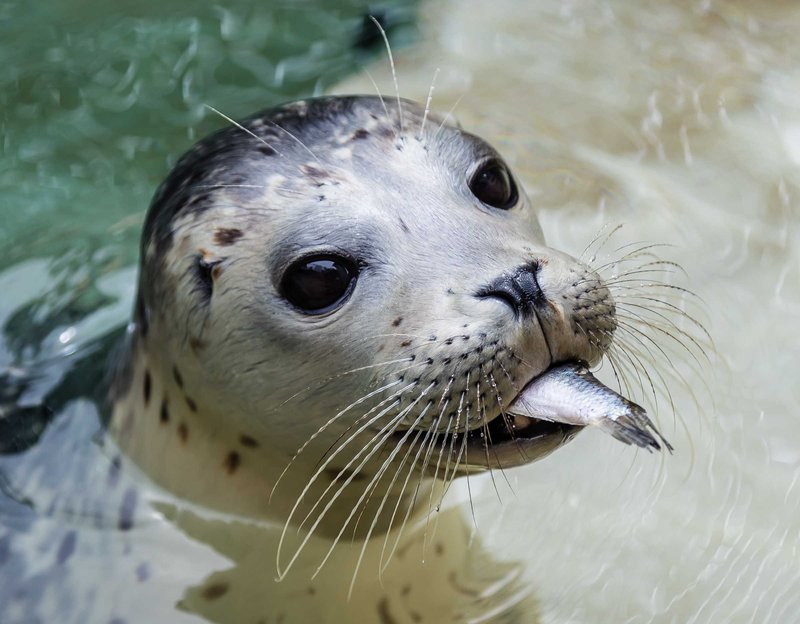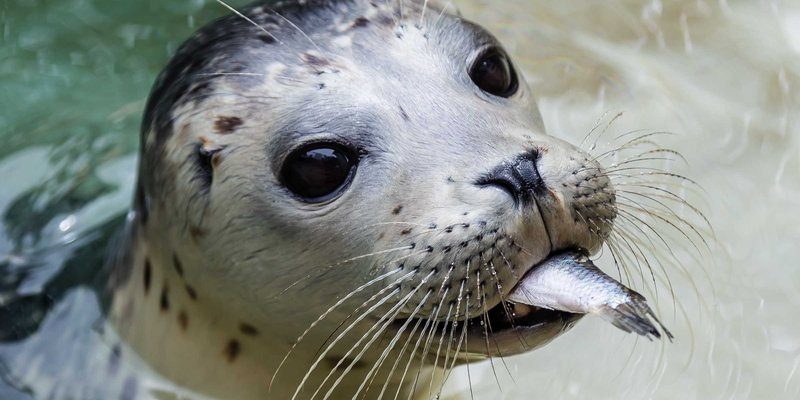
So, if you’re curious about these playful pinnipeds, let’s dive into some intriguing facts that might just surprise you. From their unique adaptations to their social behavior, there’s so much to learn about harbor seals. Let’s uncover ten cool things you didn’t know about them!
1. They Have Unique Spots
Here’s the thing: every harbor seal has a distinct pattern of spots on its fur, just like our fingerprints. These markings help researchers identify individual seals and track their movements.
When you see a harbor seal lounging on a rock, look closely at its coat. You’ll notice that some have dark spots on a light base, while others show the opposite. Each seal’s pattern is entirely unique, which adds a personal touch to their appearance. This spotting not only contributes to their charm but also allows scientists to study their population dynamics more effectively.
Additionally, these spots serve as camouflage! When they’re in the water or resting on rocky surfaces, their mottled fur helps them blend in, making it harder for predators or prey to spot them.
2. They’re Great Swimmers
You might be wondering just how well these seals can swim. Harbor seals are built for life in the water. Their bodies are streamlined, with powerful flippers that propel them gracefully through ocean currents. They can reach impressive speeds of up to 25 miles per hour when chasing fish!
What’s even cooler is their diving capability. Harbor seals can hold their breath for up to 30 minutes while diving deep in search of food. Imagine holding your breath that long! They typically dive to depths of around 600 feet, though some have been recorded going deeper for their favorite snacks, like fish and squid.
3. They Have a Unique Way of Communicating
Communication is essential for social animals, and harbor seals have their own special way of chatting. They use a combination of calls, barks, and even growls to convey messages to each other.
You might catch a glimpse of them vocalizing while they’re on land or in the water. Each vocalization can indicate different emotions or situations, such as mating calls or alarms when danger is near. It’s like they have their own little language! Researchers have found that even their vocalizations can change depending on their environment or social dynamics, which makes their communication even more fascinating.
4. They Don’t Migrate
Unlike many marine animals, harbor seals are not migratory. They tend to stick close to home, often living in the same coastal areas throughout their lives. This might seem boring to some, but it actually allows them to develop a strong connection with their local environment.
Their favorite spots usually provide ample food and safe, rocky places for resting and breeding. These seals are particularly loyal to their haul-out sites—the locations where they come ashore to rest. They have been known to return to the same spot year after year, creating a sense of community and familiarity.
5. They’re Curious Creatures
Harbor seals are naturally curious animals. When they see something new or unusual in their environment, they often investigate. This curiosity plays a vital role in their survival.
For example, you might observe a seal popping its head out of the water to check out a kayak or a boat. This behavior is not just for entertainment; it’s part of their instinctual need to understand their surroundings. They use this curiosity to learn about potential threats and food sources, ensuring they stay safe while exploring their habitat.
6. They Can Live for a Long Time
Harbor seals have impressive lifespans—often living up to 25 to 30 years in the wild. Of course, this can vary depending on factors like environmental conditions and predation.
In captivity, some harbor seals have been known to live even longer, with a few reaching ages of over 40 years. Think about that! Living so long allows these seals to accumulate a wealth of experience and knowledge about their environment, which can be advantageous for their survival.
7. They’re Sensitive to Their Environment
Like many marine animals, harbor seals are highly sensitive to environmental changes. Factors like pollution, climate change, and disturbance from human activities can adversely affect their populations.
For instance, rising ocean temperatures can influence fish populations, leading to food shortages for these seals. Additionally, habitat destruction—such as the loss of haul-out sites due to coastal development—can pose serious threats to their well-being. This sensitivity highlights the importance of conservation efforts to protect their habitats and ensure their survival.
8. They’ve Got a Solid Diet
Honestly, if you’re a harbor seal, you’re living a pretty good life when it comes to meals. They have a diverse diet, primarily consisting of fish, but they also enjoy squid, crustaceans, and other marine invertebrates.
What’s interesting is their hunting technique. Harbor seals are opportunistic eaters, meaning they’ll consume whatever is most readily available. They often use their keen sense of hearing to locate prey, even in murky waters. This flexibility in their diet is one of the reasons they’ve adapted so well to various coastal environments.
9. They Can Climb Rocks
You might not picture seals as climbers, but harbor seals have some pretty impressive skills when it comes to navigating rocky terrains. Their strong bodies and flippers enable them to haul themselves up onto rocky surfaces with surprising agility.
During low tide, you can often spot them sunbathing on rocks, where they feel safe from predators. The ability to access these elevated areas helps them stay warm and dry while also providing a great view of their surroundings. It’s a handy skill that adds to their charm and adaptability!
10. They’re Important to Ecosystems
Finally, let’s talk about the role harbor seals play in their ecosystems. These seals are critical for maintaining the balance within marine environments. By preying on fish and other marine species, they help regulate populations and contribute to overall ocean health.
When we protect harbor seals, we’re also safeguarding entire ecosystems. This means cleaner oceans, balanced food webs, and healthier marine life. It’s like a butterfly effect in action—when one species thrives, many others do as well.
In conclusion, harbor seals are more than just adorable marine mammals; they’re complex creatures with fascinating behaviors and important roles in our ecosystems. From their unique markings to their impressive swimming skills, there’s more to these seals than meets the eye. So next time you see a harbor seal, take a moment to appreciate all the cool things about them!

